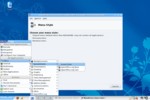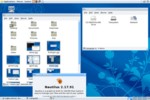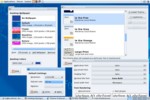Kicking the tires of Mandriva 2007.1 beta 2


 The folks at Mandriva are hard at work preparing the next incarnation of MandrivaLinux systems for home, office, and server applications. Mandriva Linux 2007.1 Beta 2 was announced yesterday and I wanted to take a look. I didn't spend a lot of time in it due to a personal showstopper, but what I saw really nice looking. So, as brief as it may be, I'd thought I'd share my experiences with my visitors.
The folks at Mandriva are hard at work preparing the next incarnation of MandrivaLinux systems for home, office, and server applications. Mandriva Linux 2007.1 Beta 2 was announced yesterday and I wanted to take a look. I didn't spend a lot of time in it due to a personal showstopper, but what I saw really nice looking. So, as brief as it may be, I'd thought I'd share my experiences with my visitors.
I downloaded the 3 gig i586 dvd as linked to by distrowatch.com and had it in about 18 hours or so. Although I didn't spot any new features or changes in the installer, it installed almost 5 gigs of software rather quickly and without issue onto my HP laptop.
Hardware detection was fairly good, a startup sound greeted me at login, but it didn't detect my graphics just right. I was offered several choices for the generic flatpanel it detected during install, but none were my desired 1200x800. I chose 1024x768 until I could edit the xorg.conf file manually. After install, I was able to tweak my resolution to 1152x768. I probably could have messed with it some more, but in my world I call that a "close enough." The touchpad worked accurately and smoothly, and an additional usb mouse was also correctly setup. Wireless is another matter and what ended my foray.
But the good stuff first. Man oh man, Mandriva is looking goood. The default fonts were pretty nice looking, but I'd probably tweak on them some. The new wallpaper is yummy. I love it. It's, of course, blue, but this time we have some nice flower silhouettes in a lighter shade of blue gracing the bottom right hand corner and some outlines in the upper left. These aren't sissy flowers now, these are nice tasteful wildflowers I guessing. Anyway, it doesn't look "girlie." It's just pretty.



The KDE panel has been simplified and redecorated as well. Others in the community speculate that Mandriva has borrowed elements from Linspire, but regardless, it's looking real nice as well. The start button looks very kbfx-ish and launcher icons are limited to Firefox and Kmail at this point. The systray is home to klipper, net monitoring, and kOrganizer. Despite some new menu implementation, they aren't changed in appearance or structure. I don't care for the mandriva menus much and always change mine back to KDE/Gnome menus in the Mandrake Control Center. The boot splash, login screen, and kde start splash match the new wallpaper perfectly and make for a complete package.
The Gnome desktop is equally appealing. The same great wallpaper decorates the background and the Ia Ora theme is still looking good in shades of blue. The panels have a nice 3d effect in an almost metallic appearance with just a hint of powder blue coloring. Add them up and you get what feels like a really polished desktop.



I didn't test a whole lot of the applications, but you might know mandriva. They include just about everything but the kitchen sink and inevitably there will be crashes here and there. In fact, the clock applet crashes in gnome at every startup unless you disable it. But this is a beta 2, so no sense in spending a lot of time running down what started, what didn't, and what crashed anyway. Especially since I couldn't get my wireless connection to work.
That's the bad news. My windows drivers dependent wireless chip couldn't be made to work with this release. The adventure started when trying to configure it during install and I just got the 'couldn't do it' error. (I'm paraphrasing of course.) Later in Mandriva I tried through the Mandriva Control Center and I got the error that "can't install wireless-tools." They did however include wpa_supplicant. Nevertheless, this wasn't the end of road for me.
What was the showstopper for me was the error received during manual setup at the commandline. I could install the windows drivers just fine, but when modprobing ndiswrapper I got the "bad magic" error. It complained that the drivers were 64-bit and the kernel was 32-bit. And it's true. I downloaded the 32-bit system. But also, for what little it may be worth here, I saw this same error with SimplyMepis more than once and using the 64-bit system didn't cure it. Also, I'd like to state that other 32-bit systems do just fine with it, such as openSUSE and PCLOS. So, for now, I'm not going to test the 64-bit version of mandriva. The weekend is over and time to get ready for the workweek, but next beta or perhaps the first release candidate will work for me. I'll let you know. In the meantime, if you have a natively supported wireless chip, you can download the wireless-tools and libiw28 rpms from a mirror and probably enjoy.
Likewise the 3D desktop will have to wait as well. I've not had much luck with Mandriva in that department, but I'll test this feature again next release.
In conclusion, Mandriva 2007 is looking really good. I really like the updated presentation Mandriva gives. I hope the wireless setback is temporary. I want for them to make a comeback so very much. Let's cross our fingers for this upcoming release. As my mama used to say about me, if Mandriva does as well as it looks it will be just fine.
-

- Login or register to post comments
 Printer-friendly version
Printer-friendly version- 55104 reads
 PDF version
PDF version
More in Tux Machines
- Highlights
- Front Page
- Latest Headlines
- Archive
- Recent comments
- All-Time Popular Stories
- Hot Topics
- New Members
today's howtos
| Red Hat Hires a Blind Software Engineer to Improve Accessibility on Linux Desktop
Accessibility on a Linux desktop is not one of the strongest points to highlight. However, GNOME, one of the best desktop environments, has managed to do better comparatively (I think).
In a blog post by Christian Fredrik Schaller (Director for Desktop/Graphics, Red Hat), he mentions that they are making serious efforts to improve accessibility.
Starting with Red Hat hiring Lukas Tyrychtr, who is a blind software engineer to lead the effort in improving Red Hat Enterprise Linux, and Fedora Workstation in terms of accessibility.
|
Today in Techrights
| Android Leftovers |








.svg_.png)
 Content (where original) is available under CC-BY-SA, copyrighted by original author/s.
Content (where original) is available under CC-BY-SA, copyrighted by original author/s.

re: Mandriva too French ?
Tuxmachines had pushed most distros to use Linus official releases to comply with Linux projects to have backward compatibility.
You'd think I'd remember saying something like that.
re: Well, you complained
I did?
I don't think that was me. I don't even use a straight linus kernel on my everyday gentoo anymore, not since 2.4. I use gentoo's hardened sources for the server and their regular sources for the desktop.
re: in your ealier reviews
hmm. maybe I did.
It's awful to get old and senile. I don't recommend it.
Thanks for the clarification
I hadn't considered Mandriva's kernel modifications as a factor in the bug fixing they have to do. I've not really looked into Ocilent1's kernels (Ocilent1 does the kernels for PCLOS) too closely, but I would guess they don't stray too far from the official kernel releases.
I think a number of other factors have contributed to Mandriva's demise.
PCLinuxOS
Isn't it ironic that a small and independent fork of Mandrake -- that which you sport in your Web site -- has gone above Mandriva, at least according to DW?
Re: Mandriva
Nice writeup Susan. I too would hate to see Mandriva go under. Or, even worse, make a pact with the devil for a quick infusion of cash like Novel/SUSE.
Not real sure what atang specifically means by 'too French'. Of course, for Mandriva, a real partnership with Dell would be ideal. But, of course, Mandriva still has yet to prove themselves with 2007.1. And, sadly, it looks like Dell isn't ready to offer installed Linux with the sale of their machines (Dell may eventually change its mind as realization sinks in about what a slow pig of an operating system MS Windows Vista really is).
PCLOS still depends on Mandriva, and although the skill set and dedication of the devs at PCLOS is sufficient to create a good distribution based on Debian or some other major branch of the distro tree, I would hate to see that happen.
PCLOS has taken the best part of Mandriva and specialized, customized, and polished it to near perfection as a 32-bit desktop Linux distro. And they've done this with just a few people and an extraordinary amount of sheer hard work.
Of course, Mepis has done the same with Debian. And 'buntu, in a more comprehensive way, has also done this with Debian.
I downloaded and installed PCLOS 2007 Test Release 3 yesterday, and watched it shine. What a great desktop distro!